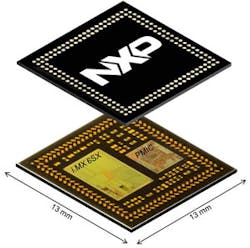The Internet of Things often means tiny and mobile, and that makes designs challenging. One alternative is to use modules delivered by vendors like NXP, Digi International, and Intel. Small modules have been available for many years, but ones with wireless support and built-in sensors have recently become more popular.
NXP’s SCM-i.MX 6SX (Fig. 1) comes in a 13- by 13-mm Package on Package (PoP). It includes an i.MX 6SoloX apps processor with a Cortex-A9 and a Cortex-M4, up to 1 Gbytes of LPDDR2 memory, 4 Gbytes of eMMC flash memory, and a PF100 power management device, plus a collection of discrete components. The SCM-i.MX 6SX includes a gigabit Ethernet interface along with display and touch support. The 0.7-mm diagonal ball pitch array targets low-cost PCB boards. There is a larger V-Link variant that incorporate’s NXP’s V-Link interface matched to off-the-shelf components for wireless support, including Wi-Fi, NFC, and Bluetooth.
Digi International’s 29-mm by 29-mm ConnectCore i.MX6UL (Fig. 2) has a 528 MHz Cortex-A7 with dual 10/100 Ethernet, Bluetooth 4.0, and 802.11a/b/g/n Wi-Fi support with on-board antenna. It comes in a 245-pad LGA (universal) or 76-pad (simple) castellated edge vias form factor. Versions are available with up to 2 Gbytes of NAND flash and 1 Gbyte of DDR3 DRAM. It uses NXP’s PF3000 PMIC. A Cortex-M0+ handles system management, and there is a dedicated security controller that works with Digi’s TrustFence Linux support.
Intel’s Curie module is built around a 32-bit, x86 Quark and an ARC DSP sensor hub. The system has 384 Kbytes of flash an 80 Kbytes of SRAM. It also has Bluetooth LE support along with a 6-axis accelerometer/gyro.
The Curie also has General Vision’s (formally CogniMem) NeuroMem’s hardware pattern matching technology with 128 neurons. The system allows applications to classify new patterns and report novelties or anomalies in real-time. Deep learning is being tackled by high-performance GPUs, but this technology is found in a compact, low-power module.
Building a platform from scratch may be useful in special circumstances or for high volume markets, but these modules can reduce time to market using the latest technology. They allow developers to concentrate on the application instead of packaging and PCB technology.
Looking for parts? Go to SourceESB.
About the Author
William Wong Blog
Senior Content Director
Bill's latest articles are listed on this author page, William G. Wong.
Bill Wong covers Digital, Embedded, Systems and Software topics at Electronic Design. He writes a number of columns, including Lab Bench and alt.embedded, plus Bill's Workbench hands-on column. Bill is a Georgia Tech alumni with a B.S in Electrical Engineering and a master's degree in computer science for Rutgers, The State University of New Jersey.
He has written a dozen books and was the first Director of PC Labs at PC Magazine. He has worked in the computer and publication industry for almost 40 years and has been with Electronic Design since 2000. He helps run the Mercer Science and Engineering Fair in Mercer County, NJ.
- Check out more articles by Bill Wong on Electronic Design
- Bill Wong on Facebook
- @AltEmbedded on Twitter


